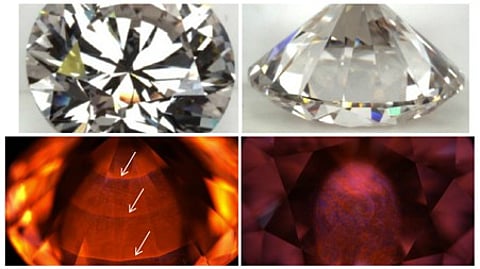

Synthetic diamonds are on the rise and happening around the world was proved when HRD Antwerp examined a 3.09 carat diamond recently. The CVD lab-grown diamond encountered at the HRD Antwerp diamond lab has a brilliant cut (measurements: 9.36 – 9.42 mm x 5.76 mm), a colour grade Slightly Tinted White (I ecg) and fluorescence nil. Microscopic examination revealed the presence of several pinpoint inclusions resulting in the clarity grade VS2. Analysis of the stone with crossed polarization indicated a pattern which is rather similar to the tatami pattern that is characteristic of natural type IIa diamonds.
In fact, both D-screen and Alpha Diamond Analyzer, instruments developed by HRD Antwerp to distinguish possible lab-grown or HPHT treated diamonds from natural diamonds, indicated that the stone needed further testing. Alpha Diamond Analyzer confirmed that the stone is a type IIa diamond and therefore potentially lab-grown or HPHT treated.
Furthermore, the diamond was thoroughly analysed using various spectroscopic techniques. Diamond View imaging was executed to analyse the growth structure of the diamond. This examination can give more information about the growing environment of the diamond. The pavilion of the analysed stone showed a layered growth structure, which is very characteristic for CVD lab-grown diamonds (Figure 3, left). Based on this figure it can also be assumed that the stone was not grown entirely in one run, but rather grown in different steps (start – stop growth, indicated by the white arrows). The table of the stone showed a somewhat cloud-like structure (Figure 3, right). Even though visual examination revealed no fluorescence (nil), Diamond View imaging showed a red and purple fluorescence. No phosphorescence was observed.
after this, the characterization of the stone was done using UV-VIS absorption spectroscopy and Photoluminescence laser spectroscopy. One of the major features that can be detected in diamonds grown by the CVD method is the SiV- centre (doublet around 737 nm). While this SiV- centre is weakly present in the spectrum obtained by UV-VIS absorption spectroscopy (Figure 4, left), it is stronger detected in the spectra taken with PL laser spectroscopy (Figure 4, right). Except for the NV0 centre, no other peaks are observed in the UV-VIS spectrum. There are no clear indications of possible colour treatment after growth.
Since lab-grown diamonds are often entering the market undisclosed, it is always recommended to do a preliminary screening (with D-screen or Alpha Diamond Analyzer) to separate potentially lab-grown or HPHT-treated diamonds from natural ones. Even more, submitting your diamond directly to a sophisticated lab like HRD Antwerp, where a team of experts not only analyses the 4 C’s, but also the origin of the stone (natural or lab- grown) and the origin of its colour, will be your best guarantee.
Follow DiamondWorld on Instagram: @diamondworldnet
Follow DiamondWorld on Twitter: @diamondworldnet
Follow DiamondWorld on Facebook: @diamondworldnet
